|
|
Aruba - General InformationImagine Las Vegas with tourquoise-coloured water and powder-white sand...
(Information courtesy of World Travel Guide) Aruba's principal attraction is its beaches; these include Arashi Beach (near California Point on the northwest tip, particularly good for snorkelling), Spaans Lagoen and Commandeurs Baai, Bachelor's Beach (good for windsurfing), and the particularly shallow areas of Baby Beach and the 'Grapefield' (all on the south coast). Near Baby Beach, at Seroe Colorado, is Rodger's Beach, where the surf is a little stronger. Beaches on the north coast include Boca Prins, Dos Playa and Andicouri. One of the attractions on this shore is the Natural Bridge, an arch carved from coral cliffs by the crashing ocean surf. The bridge is the biggest and highest in the Caribbean and is Aruba's most famous natural wonder. So too is the surf on this coast, but visitors are warned that it can be very rough. Local advice concerning conditions for surfing on the island at any particular time should be followed carefully, but there will usually be one beach somewhere to suit all levels of skill and courage. Another favourite pastime is exploring the surrounding shallow water with specially equipped submarine vessels.
Aruba's Dutch heritage is always present, and nowhere more so than in the capital of Oranjestad, characterised by pastel-coloured gabled buildings, and a windmill brought piece by piece from Holland, now
used as a restaurant. There are four museums here open to the public: the Historical Museum, the Geological Museum, the Archaeological Museum and the Numismatic Museum. The first is housed in the Fort Zoutman, the oldest building on Aruba (1796) with the Willem III-Tower having been added in 1868. One of the roads north from the capital runs inland, passing the Bubali Bird Sanctuary. Birdwatching and natural wildlife tours as well as archaeological and geological trips are available in various languages. On the northern tip of the island is the California Lighthouse set in an area of desolate sand dunes. Off this coast is the wreck of a German freighter from the Second World War which is now the home of countless exotic fish and a very popular spot for scuba divers. The Chapel of Alto Vista at Alto Vista is another popular site on the north coast. There are several systems of caves on Aruba. Fontein was once used by the Arawak Indians who were the original inhabitants of the island. On the walls of the caves are ancient drawings thought to be part of the Indian sacrificial rite. Nearby, the caves at Guadirikiri are a haven for bats. Arikok, which has been designated a national park, has by far the best preserved Indian drawings on the island. Interesting is also a visit to Frenchman's Pass where Arawak Indians defended Aruba against the French in 1700. Inland – in fact almost in the geographical centre of the island – is the old settlement of Santa Cruz, named after what is allegedly the place where the first cross was raised on Aruba. Hooiberg (Mount Haystack) looms out of the flat landscape of the interior to the northwest of Santa Cruz. A series of several hundred steps leads up to the 165m (541ft) peak, from where it is possible to see across to Venezuela. Northwest of Hooiberg is the old town of Seroe Patrishi with historical graves dating as far back as the early 18th century. Further north is the town of Noord, noted for its Church of Santa Anna, the oldest church of Aruba, with its beautiful 100-year-old hand-carved oak altar. The road from Noord turns north to the California Lighthouse (see above). North from Santa Cruz, turning back towards the coast, the road to Casibari and Ayo passes spectacular boulders, the result of some unexplained geological catastrophe. The road continues to the coast at Bushiribana, centre of the island's former gold-mining industry. Gold was discovered here in 1824 and actively mined until the beginning of World War I. Kettles and ovens used in the smelting process have been preserved. Gold was also mined at Balashi in the south. In the southeastern part of the island is Aruba's second-largest town, San Nicolas, which owed its prosperity to the oil refinery, once one of the largest in the world. To the east is the area known as Seroe Colorado, notable not only for several fine beaches but also for being the home of the local iguana community.
Why Pick Aruba? |
General Info |
Resorts |
Restaurants |
FAQ |
Things to Do |
What to Pack |
Aerial Photos |
Happy Hours |
Trip Report |
Thanks |
Links |
Site Map |
Home |
This site went online 1999. DISCLAIMER |



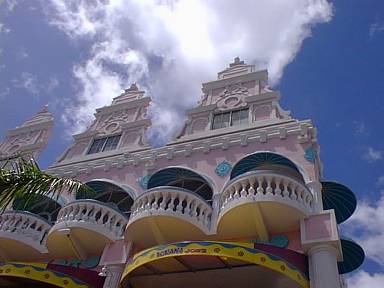
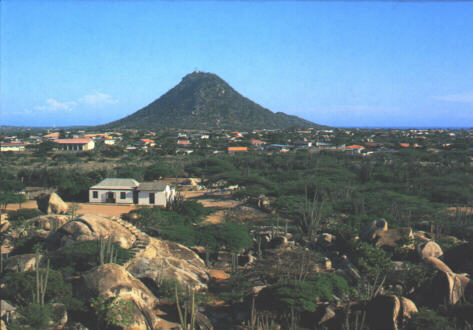
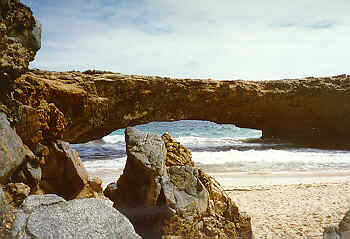


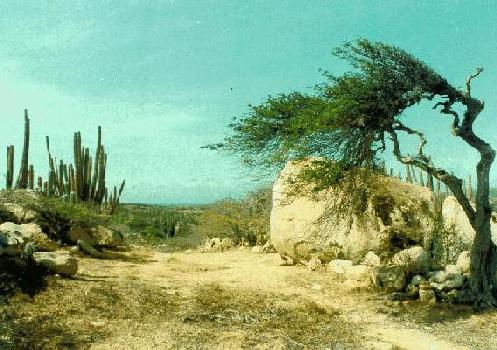



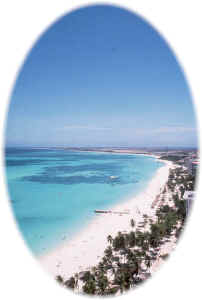 Not all of the coast is completely deserted; for instance, much of Palm Beach, the seven or so miles of sand and palm trees on the west and southwest shores of the island, has been developed into a unique hotel resort area. Low-rise resort hotels are more common on Eagle Beach, located between the point to the west of Druif Bay and south of Palm Beach. Visitors after more isolated relaxation will need to seek out
some of the more remote sunbathing and swimming spots (of which there are plenty) or turn their attention to the Cunucu: a land of cactus, windswept divi-divi trees, old villages and hamlets and unsignposted dirt roads stretching across the often mysterious landscape. The distinctive shape of the divi-divi trees (also known as watapanas) has become Aruba's unofficial trademark; blown by the northeasterly trade winds, the trees are forced to grow at alarming angles. The island can easily be driven round in a day, and cars can be hired without difficulty.
Not all of the coast is completely deserted; for instance, much of Palm Beach, the seven or so miles of sand and palm trees on the west and southwest shores of the island, has been developed into a unique hotel resort area. Low-rise resort hotels are more common on Eagle Beach, located between the point to the west of Druif Bay and south of Palm Beach. Visitors after more isolated relaxation will need to seek out
some of the more remote sunbathing and swimming spots (of which there are plenty) or turn their attention to the Cunucu: a land of cactus, windswept divi-divi trees, old villages and hamlets and unsignposted dirt roads stretching across the often mysterious landscape. The distinctive shape of the divi-divi trees (also known as watapanas) has become Aruba's unofficial trademark; blown by the northeasterly trade winds, the trees are forced to grow at alarming angles. The island can easily be driven round in a day, and cars can be hired without difficulty.